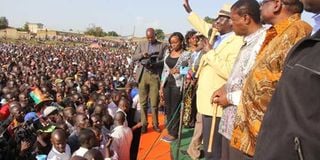Political frenzy blinds us to real security threats

Cord leader Raila Odinga (third right) speaks during a rally at 64 Stadium in Eldoret town with Bungoma Senator Moses Wetangula (second right) and Siaya Senator James Orengo on June 27, 2014. JARED NYATAYA/NATION
What you need to know:
- Since the early 1990s we have well understood the causes of violence of the sort we are now witnessing in Wajir, Baringo and Lamu.
- If we add the inflammatory effect of the war in Somalia and the discovery of fossil fuels into the mix, why are we surprised that we again see episodes of violence across the country?
Amos Cheboi personifies the malaise that Kenya finds itself in.
The senior police officer in Lamu West is no stranger to the sort of violence seen over the past couple of weeks in the area.
Before that, he served in Bungoma when violence erupted last year, Turkana in 2011 during a spate of killings at Todonyang, Kiambu during the crackdown against Mungiki in 2006, and in Marsabit at the time of the Turbi massacre in 2005.
There is no reason to doubt that, in the words of one newspaper, “bad luck” accompanied Mr Cheboi to Lamu “for the umpteenth time.”
By the same measure, it might be said, Kenya has been afflicted by bad luck for more than two decades. But we all know that there is no great mystery about political violence in our nation.
While I was reading about Mr Cheboi’s career, I was reminded of Africa Works, a seminal book written by Patrick Chabal and Jean-Pascal Daloz in 1999.
The book remains a mainstay of reading lists for classes in African politics across the globe and its contribution to the field of political science was frequently mentioned in obituaries following Chabal’s death in January.
It is controversial, but its central thesis is intriguing and influential. Chabal and Daloz argue that violence and insecurity can be politically useful for a state rather than necessarily being a danger to a government’s stability.
In other words, there are circumstances in which it is in a government’s interest to either encourage or not address insecurity.
Kenya is often cited as an example, proving Chabal and Daloz’s thesis. In the 1990s, the Moi government attempted to solidify its support by encouraging violence that was meant to discredit the Opposition and multiparty democracy.
BRIEF POLITICAL CONSENSUS
Can a similar charge be made against the current government? Does the state actually want to eradicate insecurity or does a certain level of political violence serve a useful purpose?
While I will be critical of the current government in the following paragraphs, the Opposition have little moral authority on this issue.
Whether in Kanu, Narc, ODM or the Government of National Unity, Cord’s leaders were just as incapable of addressing insecurity as their counterparts in the Jubilee Government.
Since the early 1990s we have well understood the causes of violence of the sort we are now witnessing in Wajir, Baringo and Lamu.
Events such as the killings in each of these counties are the result of the same dynamics that result in the distribution of hate leaflets in Nakuru.
Land disputes, an over-powerful Executive, an ineffective police force, political patronage of militias, restrictions on democratic freedoms, a collapse in the authority of institutions combine with competing ethnic identities to produce political violence.
But since the 1990s, we have also understood what the solutions to this situation are: constitutional reform, investigation and restitution of historical grievances, free and fair elections, and a strengthening of institutions.
In a brief moment of political consensus after the post-election violence of 2007/8, a set of reforms was put in place to address the causes of the chaos.
But what is the current state of these reforms? Devolution is mired in disputes between governors and national legislators.
The International Criminal Court cases seem in disarray and local prosecutions have not taken place.
DISCREDITED OUTDATED METHODS
Police reforms have stalled and Judiciary changes limited.
The Truth, Justice and Reconciliation Commission’s report has been ignored. The credibility of the Independent Electoral and Boundaries Commission is in tatters. And no progress has been made on land reforms.
If we add the inflammatory effect of the war in Somalia and the discovery of fossil fuels into the mix, why are we surprised that we again see episodes of violence across the country?
At the same time, almost every substantive measure intended to prevent future violence has been undermined or reversed.
The government has turned to discredited, outdated methods of countering dissent.
Lest we forget, banning Opposition rallies, railing against imaginary foreign plots and consolidating power around the president did not prevent violence in the 1990s.
In fact, these were the conditions that made the violence around the 1992 and 1997 elections worse. Similar measures will not help the situation now either.
Between 1991 and 2010, Kenyans of all ethnicities and of all parties debated and designed a series of reforms and institutions that retain the potential to address some of the issues that lie at the heart of the country’s troubled recent history.
In that time we learned that democracy is the best guarantor of security, but this lesson is in danger of being forgotten in a moment of political frenzy.
Prof Branch teaches history and politics at the University of Warwick





